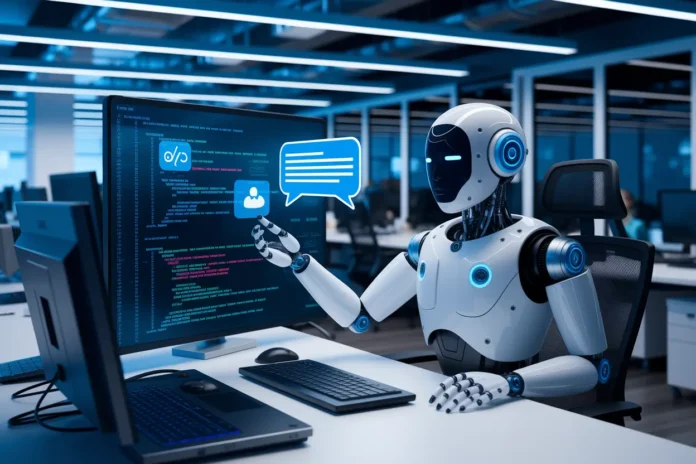AI Chatbots in IT Helpdesks are transforming the way support is delivered by automating responses, improving productivity, and ensuring availability around the clock. Utilizing advanced natural language processing (NLP) and machine learning (ML), these intelligent virtual agents provide IT assistance by simulating human conversations, understanding user intent, and resolving queries effectively. In this comprehensive guide, we’ll explore how AI chatbots operate in IT environments, their advantages, challenges, real-world use cases, and what lies ahead in their future development.
Introduction to AI Chatbots in IT Helpdesks
AI Chatbots in IT Helpdesks are designed to handle repetitive tasks and offer first-level support to users by automating troubleshooting procedures and query resolution. These bots are powered by AI algorithms that understand user language and respond with relevant solutions by interfacing with IT systems such as ticketing platforms, databases, and internal documentation.
How AI Chatbots in IT Helpdesks Work
These chatbots follow a standardized process involving:
- Input Analysis: Understanding the user query through NLP.
- Intent Recognition: Identifying what the user wants.
- Response Generation: Delivering accurate, helpful answers through predefined rules or learning models.
- Integration: Compatibility with internal systems enables ticket generation, password resets, and more.
Key Components of AI Chatbots in IT Helpdesks
For optimal performance, AI chatbots leverage these core features:
- NLP Capabilities: Interpret and understand natural human language.
- ML Algorithms: Learn from every interaction to improve accuracy over time.
- Integrations: Connect with ticketing systems (e.g., Jira, ServiceNow) and knowledge bases.
- Task Automation: Automatically resolve basic issues like account access and installation help.
Top Advantages of AI Chatbots in IT Helpdesks
Implementing AI chatbots brings substantial benefits:
- Improved Efficiency: Bots handle multiple queries simultaneously, reducing response times and boosting staff productivity.
- Cost Savings: Automating common inquiries lowers staffing and training costs.
- 24×7 Availability: Users receive support anytime, without scheduling constraints.
- Scalability: Rapid accommodation of fluctuating support request volumes.
Challenges of AI Chatbots in IT Helpdesks
Despite their usefulness, there are certain limitations:
- Complex Problems: Bots often lack the reasoning to resolve unique or multifaceted queries.
- User Experience Gaps: Misinterpretation of input can frustrate users.
- Maintenance Overhead: Regular updates and expanded training data are necessary for sustained accuracy.
Common Use Cases for AI Chatbots in IT Helpdesks
Popular applications of AI chatbots include:
- Password Resets: Walkthroughs and direct reset capabilities.
- Software Install Assistance:

Detailed instructional support via chat.
- Basic Troubleshooting: Fixes for internet issues, login failures, device crashes.
- Ticket Management: Auto-generation, updating, and escalation of help tickets.
Real-World Success Stories of AI Chatbots in IT Helpdesks
Organizations relying on AI chatbots have seen remarkable performance improvements:
- McAfee: Achieved a 74% automation in ticket resolution, cutting down support costs and improving agent efficiency by 75%.
- Zendesk’s Answer Bot: Smart routing and article suggestions allowed self-resolution of basic tickets, reducing agent involvement.
Latest Trends in AI Chatbots in IT Helpdesks
Reflecting the evolution of AI, emerging trends include:
- Generative AI: Enabling deeper, context-aware conversations through transformer-based language models.
- Predictive IT Support: Bots anticipate future user needs based on usage patterns.
- Hyper-Personalization: Customizing interactions based on user history and preferences.
Technical Tips for Deploying AI Chatbots in IT Helpdesks
To ensure long-term scalability and effectiveness, follow these tips:
- Objective Setting: Define KPI goals — reduced resolution times, minimized human escalation, ticket deflection percentage.
- Platform Selection: Choose tools compatible with enterprise systems and IT workflows.
- Knowledge Base Creation: Train the bot using accurate, frequently updated content.
- Continuous Model Training: Incorporate new user queries and edge cases to enhance learning.
Comparing AI Chatbots in IT Helpdesks vs Alternatives
| Technology | Interactivity | Speed | Cost |
|---|---|---|---|
| AI Chatbots | High | Instant | Low |
| Traditional Helpdesk | Medium | Slower | High |
| Email Support | Low | Delayed | Medium |
| Self-Service Portals | Medium | Fast | Low |
Best Practices to Maximize AI Chatbots in IT Helpdesks
To optimize outcomes:
- Test Thoroughly: Validate bot flows through multiple QA cycles before full rollout.
- Gather Feedback: Utilize real user input to eliminate redundant paths or misinterpretations.
- Improve Onboarding: Train users on bot capabilities to increase adoption and trust.
AI Chatbots in IT Helpdesks: Future Outlook
The adoption curve is just starting. Future AI chatbots are likely to:
- Resolve more complex queries with emotional detection and reasoning.
- Deliver smoother omnichannel support via Slack, Teams, email, and web.
- Integrate robotics process automation for backend task completion.
FAQs: AI Chatbots in IT Helpdesks
What tasks can AI chatbots handle in IT support?
AI chatbots can automate tasks such as password resets, ticketing, software installation help, and resolving common connectivity issues.
Are AI chatbots replacing IT support agents?
No. Chatbots assist by reducing repetitive workloads, allowing human agents to focus on complex and high-priority issues.
How accurate are AI chatbots in IT helpdesks?
The accuracy improves over time with consistent training and user interaction, often reaching over 80% resolution for standard queries.
What systems can chatbots integrate with?
They can integrate with ITSM platforms like ServiceNow, Jira, databases, knowledge bases, and email systems.
Do AI chatbots require ongoing updates?
Yes, continuous data training, knowledge management, and language updates are essential for long-term performance.
Conclusion: The Value of AI Chatbots in IT Helpdesks
AI Chatbots in IT Helpdesks have revolutionized how IT support operates, offering unrivaled efficiency, lowered costs, and 24/7 availability. From handling routine tasks to proactively identifying potential system flaws, these intelligent solutions not only improve service delivery but also future-proof IT operations in a rapidly digitizing world. Investing in AI chatbot technology is no longer optional but essential for organizations aiming at scalable and consistent IT support.




